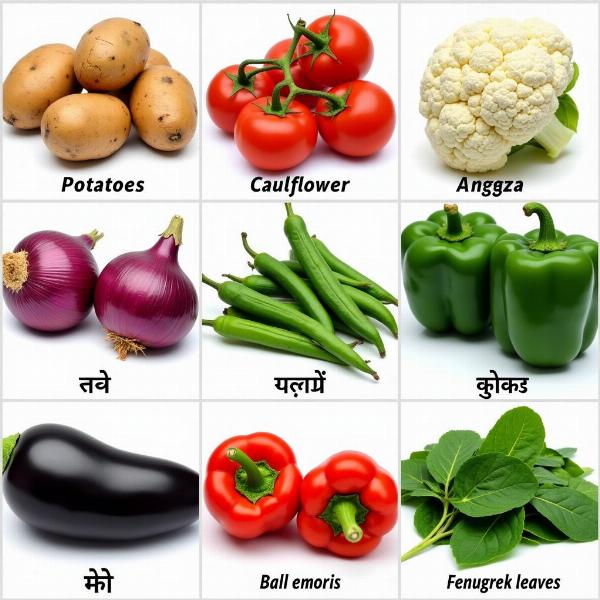Knowing the sabji name in Hindi is essential for anyone navigating the vibrant world of Indian cuisine, whether you’re a seasoned cook, a curious foodie, or simply trying to order vegetables at a local market. This guide provides a comprehensive list of common Indian vegetables in Hindi, along with helpful tips and cultural insights to enrich your understanding.
Exploring the Diverse World of Sabji
Indian cuisine is renowned for its incredible variety of vegetarian dishes, and vegetables, or sabji, play a pivotal role. From leafy greens like palak (spinach) to root vegetables like aloo (potato), the options are endless. Understanding the sabji name in Hindi allows you to unlock the secrets of authentic Indian recipes, explore regional specialties, and appreciate the nuances of this rich culinary heritage.
Common Sabji Name in Hindi: From Aloo to Zucchini
Let’s delve into a list of frequently encountered sabji names in Hindi:
- Aloo (आलू): Potato – A staple in Indian cooking, used in countless dishes.
- Pyaaz (प्याज): Onion – The foundation of many Indian gravies and curries.
- Tamatar (टमाटर): Tomato – Adds tanginess and richness to various preparations.
- Gobi (गोभी): Cauliflower – A versatile vegetable used in curries and stir-fries.
- Bhindi (भिंडी): Okra – Popular for its slightly slimy texture when cooked.
- Baingan (बैंगन): Eggplant/Brinjal – Used in curries, roasted dishes, and Bharta.
- Shimla Mirch (शिमला मिर्च): Bell Pepper/Capsicum – Adds a vibrant color and crunch to dishes.
- Matar (मटर): Peas – Commonly used in curries and rice dishes.
- Palak (पालक): Spinach – A nutritious leafy green used in Saag and other preparations.
- Methi (मेथी): Fenugreek Leaves – Adds a distinct aroma and flavor to dishes.
 Common Indian Vegetables Display
Common Indian Vegetables Display
Regional Variations and Seasonal Specialties
India’s vast geographical diversity influences the types of sabjis consumed in different regions. Certain vegetables are seasonal specialties, adding a unique dimension to the culinary landscape. For example, karela (bitter gourd) is a popular summer vegetable, while sarson ka saag (mustard greens) is a winter delicacy. Learning the sabji name in Hindi for these regional and seasonal varieties enhances your understanding of Indian cuisine’s complexity.
Beyond the Basics: Exploring Lesser-Known Sabjis
While the above list covers commonly used vegetables, Indian cuisine boasts a wealth of lesser-known sabjis. These include tinda (Indian round gourd), parwal (pointed gourd), and khesari (grass pea). Exploring these unique vegetables opens up a whole new world of flavors and textures.
Conclusion: Mastering the Sabji Name in Hindi
Understanding the sabji name in Hindi is a gateway to appreciating the richness and diversity of Indian cuisine. By familiarizing yourself with these names, you can confidently navigate Indian markets, follow recipes, and explore the vast world of Indian vegetarian cooking.
FAQ
- What is the Hindi word for carrot? Gajar (गाजर).
- How do you say radish in Hindi? Mooli (मूली).
- What is the Hindi name for pumpkin? Kaddu (कद्दू).
- How do you say green beans in Hindi? French beans are called “French Beans” (फ्रेंच बीन्स) and flat beans are called “Sem” (सेम).
- What is the Hindi name for sweet potato? Shakarkand (शकरकंद).
- How do I say cucumber in Hindi? Kheera (खीरा).
- What’s the Hindi name for cabbage? Patta Gobhi (पत्ता गोभी).
Meaning-Hindi.in is your one-stop solution for all your Hindi translation needs. We offer a wide range of professional translation services, from business and legal documents to technical manuals and website localization. Our expert team ensures accurate and culturally sensitive translations, helping you bridge the communication gap effectively. Whether you need document translation, website localization, or interpretation services, we have the expertise to meet your requirements. Contact us today at [email protected] or call us at +91 11-4502-7584. Meaning-Hindi.in is dedicated to delivering high-quality Hindi translation services tailored to your specific needs.